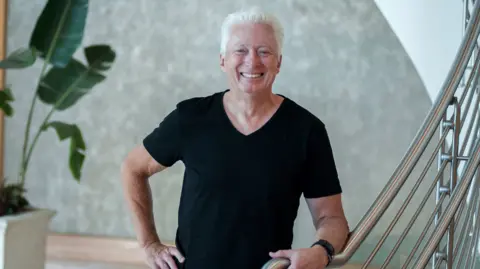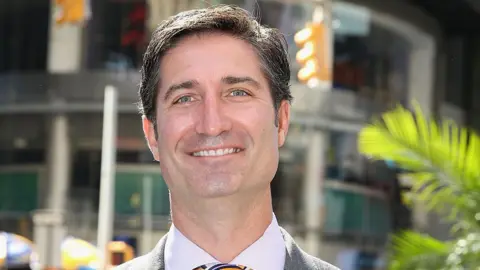 Alan Lafley
Alan LafleyBoeing, Nike and Starbucks have all changed their chief executives in recent months. But just how important is the person in the top job for the successful running of such huge companies?
“There’s only one cat who’s on the hot seat,” says Alan Lafley, who was CEO of global consumer goods giant Procter & Gamble from 2000 to 2010, and then again from 2013 to 2015.
With P&G selling everything from Pampers nappies, to Head & Shoulders shampoo, and Fairy washing up liquid, it has more than five billion customers around the world. And its workforce now exceeds 107,000 people.
Mr Lafley equates leading a firm of that vast size with being the manager of one of England’s Premier League football teams. Specifically, he says the job comes with the same risk of being sacked if results are not as good as expected.
“With the football players, if they have a bad season, they’re not gone,” he says. “Instead it is the coach or manager that’s going to go.”
Coffee giant Starbucks announced a change of CEO in August, following falling sales caused by factors including a complicated menu, tough competition in China, and boycotts linked to the war in the Middle East. The hope is that new boss Brian Niccol can transform the firm’s fortunes.
To lure him away from the success he was enjoying running US restaurant chain Chipotle, Starbucks is paying him more than $100m (£79m) in his first year, plus the use of a private jet to allow him to commute 1,000 miles from his home in California to the firm’s head office in Seattle, Washington state.
“It’s pretty obvious that there’s a big hope for him and his ability to turn that company around,” says executive coach Alisa Cohn, who explains that top pay packages are set by a company’s board of directors, and reflect their expectations of the CEO they’re appointing.
Investors welcomed Mr Niccol’s appointment with a 24.5% jump in Starbucks share price the day it was announced. The same day Chipotle fell 7.5%.
Mr Niccol is now continuing efforts to simplify Starbucks’ menu.
“CEOs are the ones who are setting the strategy for the company,” adds Ms Cohn. “They’re the ones setting the culture for the company, and, truthfully, the buck stops with them in terms of their accountability.”
 Getty Images
Getty ImagesMarcia Kilgore is a Canadian entrepreneur behind skincare brands Soap & Glory and Beauty Pie, plus footwear firm Fitflop. She says that the role of CEO is complicated, demanding, and critical to a company’s success.
“You need to have somebody who can really look at the different streams of work that need to be done, and make those organised and prioritised,” she adds.
“And someone who can make sure that the different teams in the company are working together harmoniously, and ensuring that time is not wasted, money is not wasted, and energy is not wasted on things that are not going to move the dial for the company.”
The failure to make the right choices and lead teams in the right direction was why Mr Lafley became the boss of P&G in 2000.
His predecessor Durk Jager resigned as a result of the failure of a huge global restructuring that he led. Cutting 15,000 jobs and 10 factories was meant to increase profits, but instead led to repeated profit warnings and a steep share price collapse.
Mr Lafley says that as CEO it’s not about doing everything yourself, but “enabling and empowering everybody in the organisation” to do what needs to be done.
“We had 100,000 people looking to the new CEO to tell them two things – ‘what happened?’, and ‘what are we going to do next?’.”
He explains that he decided to refocus the firm on serving customers and innovating new products, telling staff that “I have confidence that we’re all going to get us out of where we are and back on track”.
Mr Lafley adds that clearly communicating his plans with employees was so “hugely important” that in those pre-Zoom days he flew around the world to meet staff in person.
Inspiration and communication are also seemingly at the heart of the approach of new Nike CEO Elliott Hill. On getting the job in September he wrote to staff telling them he had “great confidence in his team and our future together” despite years of falling sales.
 Getty Images
Getty ImagesMs Cohn who has worked with companies including Google, Etsy and Johnson & Johnson says that whatever the plans of a new CEO, confidence is vital for any success.
“The most important quality that you need to be the CEO is knowing that you will be able to be the CEO,” she says. “There is a sense of confidence, and healthy ego that you need to bring to the table.
“The second thing you need to bring to the table is an ability to adapt. You’ve got to be able to assess the situation, make some important decisions, and then adapt them as you go”.
It’s not something she thinks can always be taught, which is why she says so many people get “stuck” at lower levels in a company. Ms Cohn adds: “You need to develop your own sort of internal state to know that you can handle the pressure, the difficulty, the spotlight”.
 Phillip Van Nostrand / Alisa Cohn
Phillip Van Nostrand / Alisa CohnThat pressure is one the reasons why top CEO’s are often compensated with huge pay packages. When it comes to the S&P 500 group of the US’s biggest companies last year, the top earner was Hock Tan at Broadcom who got $162m, followed by Nikesh Arora with $151m at cybersecurity firm Palo Alto Networks, and Stephen Schwarzman with $120m at investment giant Blackstone.
The average for an S&P500 CEO last year was a record $16.3m, according to executive consultants Equilar. It means they are getting 196 times as much as the average worker at their companies and critics says CEO’s aren’t worth that much more than their staff.
“This is based on the foolish notion that the person in the corner office is somehow almost single-handedly responsible for corporate value,” says Sarah Anderson from the Washington based progressive think tank the Institute for Policy Studies.
She think it’s a problem that is getting worse, and spreading around the world. “I think runaway CEO pay is bad for our economy, bad for democracy and bad for business,” she adds.
Mr Lafley agrees that the ratio between staff and CEOs’ pay is “too high”, but reasons that firms are having to compete to attract the best talent.
He thinks the answer lies in paying CEOs “a rather modest basic salary, and then everything else is incentive”.
“In the end, it’s sort of like a coach. If you’re not motivating people, and you’re not enabling them to do what you’re asking them to do, then you’re not doing the job.”




